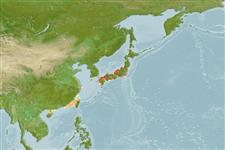>
Gobiiformes (Gobies) >
Gobiidae (Gobies) > Gobionellinae
Etymology: Pterogobius: Greek, pteron = wing, fin + Latin, gobius = gudgeon (Ref. 45335).
More on authors: Jordan & Snyder.
Environment: milieu / climate zone / depth range / distribution range
Ecologia
marino demersale; distribuzione batimetrica 5 - 30 m (Ref. 37679), usually ? - 10 m. Temperate
Northwest Pacific: Japan and Cheju Island in the Yellow Sea.
Length at first maturity / Size / Peso / Age
Maturity: Lm 10.0, range 9 - 11 cm
Max length : 16.2 cm TL (female)
Found in shallow rocky bottoms from 5m down to 30 meters (Ref. 37679). They are solitary dwellers and live around nests buried under stones (Ref. 37679).
Oviparous. Spawning takes place under nest stones (Ref. 37679). Egg masses are guarded by males (Ref. 37679).
The male hovers around the female to initiate the courting phase, fully extending all his fins, opening his mouth, showing his gills, and slowly fanning his caudal fin. The body and fins of the male turn black, in contrast to the reddish orange margins of the dorsal and caudal fins. The female doesn't show any color change (Ref. 37679).
Masuda, H., K. Amaoka, C. Araga, T. Uyeno and T. Yoshino, 1984. The fishes of the Japanese Archipelago. Vol. 1. Tokai University Press, Tokyo, Japan. 437 p. (text). (Ref. 559)
IUCN Red List Status (Ref. 130435)
Threat to humans
Harmless
Human uses
Informazioni ulteriori
Age/SizeAccrescimentoLength-weightLength-lengthLength-frequenciesMorfometriaMorfologiaLarveDinamica popolazioni larvaliReclutamentoAbbondanzaBRUVS
BibliografiaAcquacolturaProfilo di acquacolturaVarietàGeneticaElectrophoresesEreditarietàMalattieElaborazioneNutrientsMass conversion
Strumenti
Special reports
Download XML
Fonti Internet
Estimates based on models
Preferred temperature (Ref.
123201): 14.2 - 21.7, mean 19 °C (based on 120 cells).
Phylogenetic diversity index (Ref.
82804): PD
50 = 0.5625 [Uniqueness, from 0.5 = low to 2.0 = high].
Bayesian length-weight: a=0.01000 (0.00349 - 0.02862), b=3.09 (2.85 - 3.34), in cm total length, based on LWR estimates for this (Sub)family-body shape (Ref.
93245).
Trophic level (Ref.
69278): 3.1 ±0.1 se; based on size and trophs of closest relatives
Resilienza (Ref.
120179): Alto, tempo minimo di raddoppiamento della popolazione meno di 15 mesi (tm=1).
Fishing Vulnerability (Ref.
59153): Low vulnerability (10 of 100).
Nutrients (Ref.
124155): Calcium = 102 [52, 251] mg/100g; Iron = 0.498 [0.227, 1.052] mg/100g; Protein = 17.6 [15.6, 19.3] %; Omega3 = 0.364 [0.150, 0.786] g/100g; Selenium = 10.6 [4.6, 25.1] μg/100g; VitaminA = 14.5 [3.2, 61.4] μg/100g; Zinc = 0.878 [0.581, 1.352] mg/100g (wet weight);
